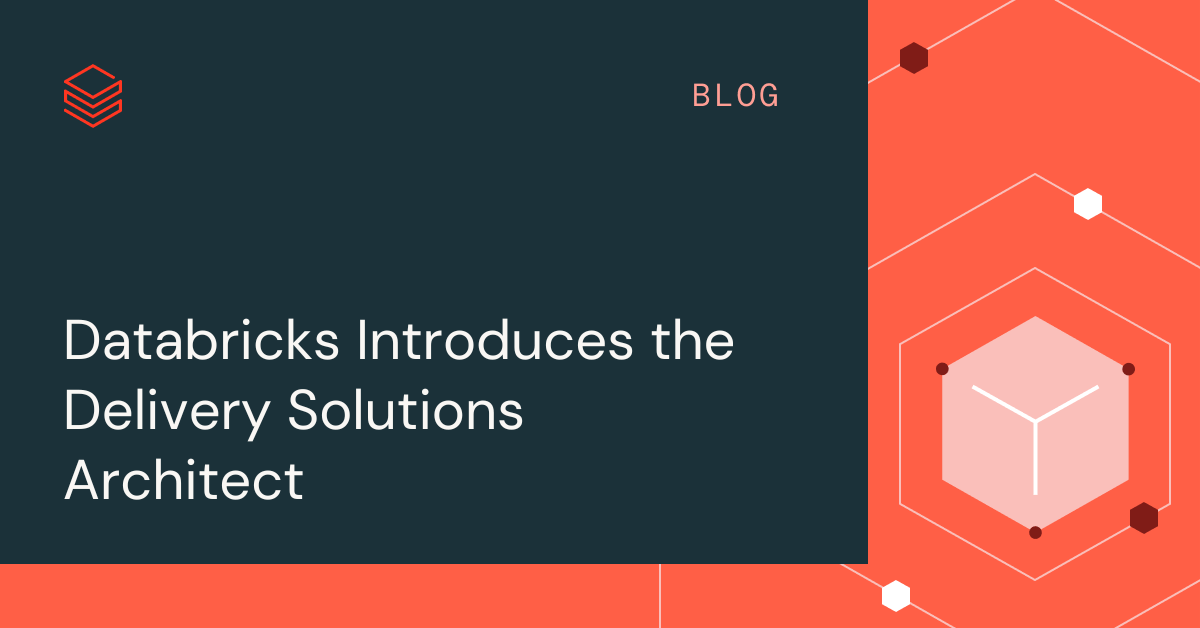Databricks introduces the Delivery Solutions Architect
Leading the Data Journey to streamline and accelerate your AI Initiatives

At Databricks, we are constantly evolving to meet the ever-changing needs of our customers. This year, we launched a new role that aims to revolutionize the way businesses leverage data and achieve higher data literacy: the Delivery Solutions Architect (DSA).
This role is an integral part of our Field Engineering function, serving as a strategic delivery and technical advisor for our customers. The DSA’s primary objective is to streamline and accelerate data and AI initiatives that can take a customer to the next stage of their data journey. This blog post will walk through the main function of the DSA and how you, as a customer or user, can expect to work with them!
Driving business value and enhancing customer experience
When first engaging with a DSA, you'll discuss your data journey, the business problem your team is solving, as well as the technical components you have used to tackle them. A DSA will become deeply familiar with your priorities, business and technical needs, and offer guidance in the three main success pillars: people, process and technology. Of these three pillars, the one where we've been asked for the most dedicated support from our customers relates to the processes needed to ensure quick turnaround of data products and technical capabilities. For this reason, the new role we created focuses specifically on helping customers accelerate getting their projects live by combining technical and business acumen, cloud data architecture and programme delivery expertise.
The DSA's success is intrinsically tied to the successful and timely go-live of customer projects. This is why a DSA has the remit to assign technical and business resources to key initiatives, supporting the delivery of tailored solutions that enable faster time to value and drive impactful business outcomes.
Benefits of Having a DSA
Streamlined data and AI initiatives are a core facet of our approach. Customers experience the convenience of a single point of contact, which simplifies project management and the execution of data and AI ventures. Our DSAs seamlessly integrate into the customer's team, offering continuous guidance and support throughout the program's execution. Their focus is directed towards allocating the right resources to expedite ROI and diligently tracking success metrics.
Our commitment to tailored solutions is unwavering. DSAs collaborate closely with customers to craft strategies that align precisely with their distinctive business goals. This personalized methodology guarantees the extraction of maximal value from data assets, resulting in not only accelerated growth but also a substantial competitive edge.
Moreover, our DSAs take the lead in driving enhanced user adoption of our Lakehouse data platform. They empower customers to harness the platform's full range of capabilities through comprehensive training, guidance, and ongoing support. This active approach ensures that customers fully capitalize on their investment, reaping the multitude of benefits it brings.
Methodology:
DSAs follow a tested methodology to ensure timely and effective completion of projects and programmes, summarized in the following steps:
Plan & Prioritize: The process involves initiating a use case discovery phase to comprehensively grasp the intricacies of each use case, encompassing aspects like data sources, outputs, dependencies, SLAs, value propositions, and anticipated activities. Simultaneously, a thorough comprehension of the customer's team learning and enablement requirements is gained. Subsequently, an execution plan is formulated, encompassing priorities, crucial deliverables, possible obstacles, and interdependencies that need to be addressed.
Architecture design: In this phase, architecture design workshops are necessary to delve into present and future architectural landscapes. The focus extends to dependencies, security, and governance intricacies, ensuring a holistic view. This is followed by an in-depth discussion to finalize a delivery plan. This plan encompasses pivotal activities, precise timelines, potential challenges, interdependencies, and well-defined responsibilities, all collectively contributing to the seamless execution of the programme.
Execution: An ongoing motion that entails working iteratively on three project pillars:
- Processes that ensure that a strong governance framework is set up to align actions with goals, manage the transition period, and ensure compliance with best practices. It also includes change management for smooth transitions, and a metrics system to measure progress, identify improvements, and enhance decision-making.
- People are at the core of the data journey, hence why it is so important to empower teams through structured learning, and fostering engagement via showcase sessions and customer communities. These efforts enhance efficiency, innovation, and collaboration.
- Technology serves as an encompassing enabler with diverse dimensions. Providing technical guidance involves swiftly resolving support issues, sharing optimal practices for process enhancement, and addressing queries about emerging features and potential optimizations. It encompasses both retrospective and forward-looking aspects. The retrospective lens acknowledges that architecture and modernization aren't immediate processes; thus, legacy tools might coexist with new ones during the transition. Simultaneously, the approach looks ahead to ensure a well-defined end-state. This methodology guarantees smooth operations, continual advancement, and the current utilization of the platform's potential.
Testing and fine tuning: Testing and fine-tuning applies to all three pillars delineated above. It ensures that a programme is following an exact delivery framework, not only with respect to technology but people and processes as well.
Closing: Focusing on making sure a blueprint or framework for repeatability has been created. The process includes collecting customer feedback, sharing lessons learned with other teams across the organization, as well as conducting an executive update that will summarize the work performed, challenges, and value added. The blueprint must also encompass not only technology aspects, but people and processes too.

The Power of Digital Transformation:
We firmly believe that AI is driving the future of product and software innovation, and this trend is already unfolding in the market. The companies and executives that will emerge as leaders in the next generation will be those who possess a deep understanding of AI and effectively harness its power to their advantage.
In our recently published 2023 State of Data + AI report, we share patterns and market trends evidenced through analyzing the data journey of more than 9,000 global customers. This analysis reveals the rapid evolution of the market, and the need for a governance framework for Data & AI projects which we hope our newly created function will support and nurture.
We firmly believe that the introduction of DSAs will catalyze faster digital transformation across industries. By leveraging their expertise and the capabilities of our Lakehouse data platform, we enable businesses to stay ahead of the curve and thrive in the digital age.
Conclusion:
The launch of the Delivery Solutions Architect role represents our commitment to providing unparalleled value and support to our customers. DSAs will serve as trusted partners in our customers' digital transformation journey, accelerating time to value and empowering them to achieve their business goals.
We are excited to lead the way in this market transformation and invite you to join us on this groundbreaking journey.
Contact us today to explore how our DSAs can drive your organization's success and propel you toward a future of unlimited possibilities.

